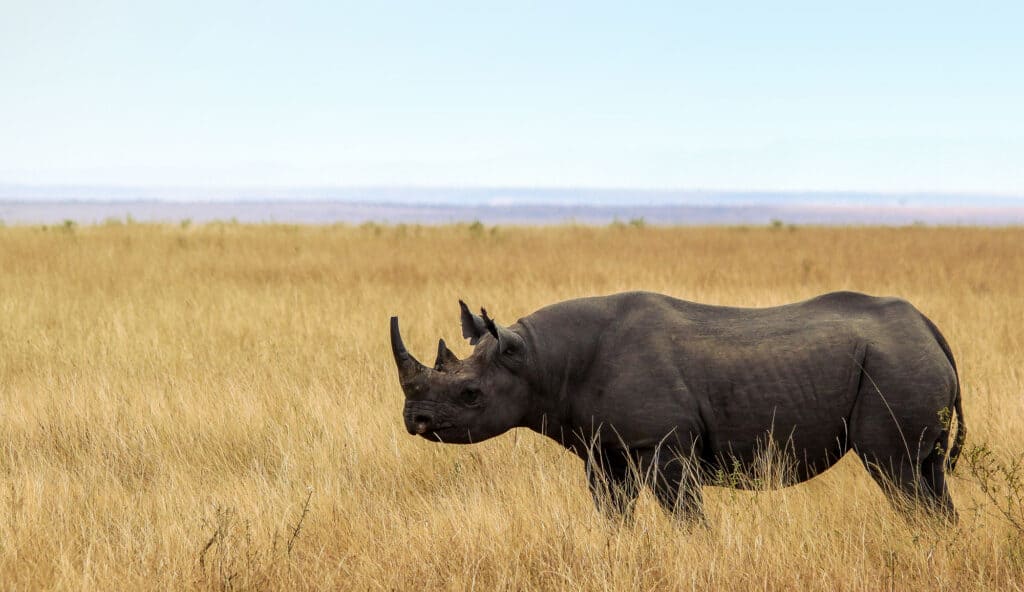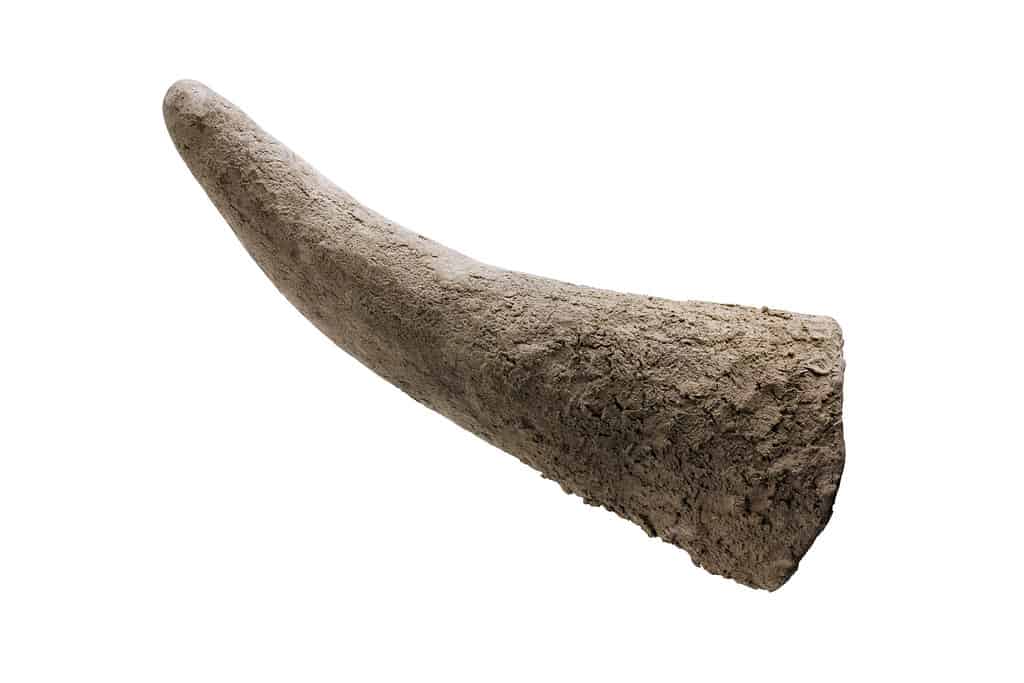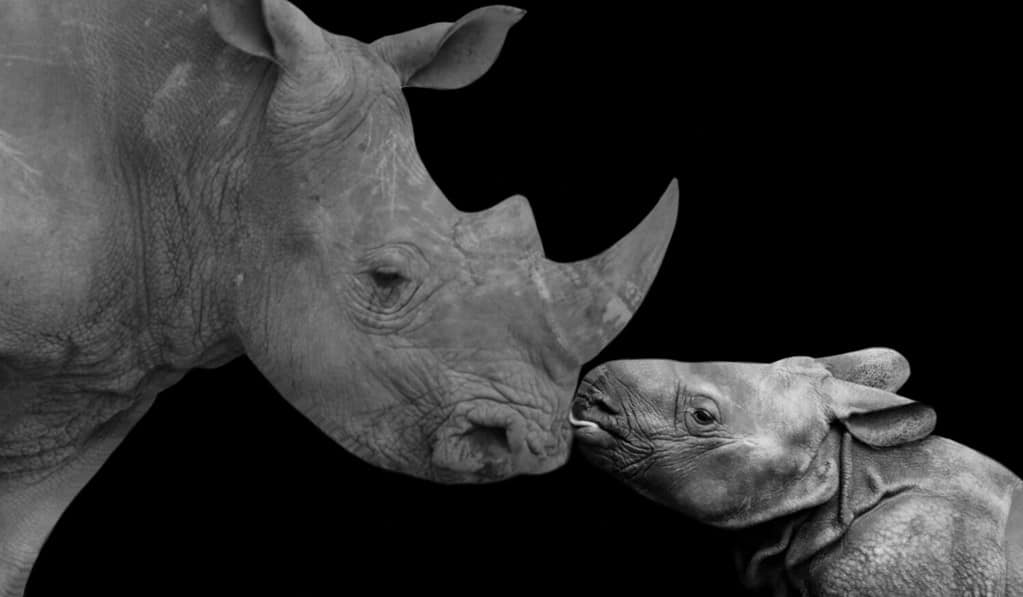Black rhino numbers are increasing, but there’s still a long road ahead.
Black rhinos are the third largest rhino species. These horned herbivores can stand 5.5 feet at the shoulder, be 12.5 feet long, and weigh 3,000 pounds. They also grow the longest horn, with the front horn sometimes reaching 4 feet long. In this article, we’ll be exploring the history of black rhino populations, and what their endangered status is now.
Is there hope for the black rhinos? Read on to learn more.
About Black Rhinos
The existing black rhinos in Africa live in 12 different countries, with especially large populations in South Africa and Kenya. Here they can survive in both the grassland, floodplains, and scrubland. Using their hooked upper lip, black rhinos find it easy to feed from low-lying tree limbs.
Left undisturbed, a black rhino can live for over 35 years in the wild. You can usually find this species covered in mud, which is where they get their name. That’s right, black rhinos aren’t actually black at all. Like white rhinos, and all rhinos, black rhinos are actually gray. They only appear black after lying around in the mud.
Are Black Rhinos Endangered?

Black rhinos are considered a critically endangered species.
©iStock.com/Black Rhinoceros, Rhinoceros, Savannah, Tanzania, Animal
Yes, black rhinos are endangered. They’re on the IUCN’s Red List of Threatened Species as “Critically Endangered”. The good news is that their numbers are slowly, but steadily increasing. If more conservation efforts are made, these rhinos could once again have large populations. Fun fact; when a group of rhinos gather it’s called a crash.
How Black Rhinos Are Left?
There are approximately 6,487 black rhinos worldwide. Out of all five rhino species, black rhino populations had the most severe decline. The only remaining black rhino sub-species are the Eastern black rhino, South Western black rhino, and Southern Central black rhino. Unfortunately, a sub-species from West-Central Africa has recently become extinct.
Between 1960 and 1995 black rhinos experienced a 98% drop in numbers. What used to be 65,000 black rhinos running around dwindled to a mere 2,500 or less. Concentrated conservation efforts are helping all black rhinos climb their way back from the brink of extinction. The numbers are increasing, but still have a long way to go before there no longer considered a critically endangered species.
What Happened to the Rhinos?

Poachers target rhinos for their horns which sell for a hefty price tag.
©Etienne Outram/Shutterstock.com
Habitat loss and poachers are the biggest threat adult black rhinos face. As long as people are willing to pay for rhino horns, poachers are willing to kill to get them.
Black rhinos have two horns. The front horn is usually the largest and can measure between 20 to 50 inches or larger. The smaller rear horn is usually just under 2 feet long. This two-horn set-up earned them their scientific name, “Diceros bicornis”. Di translates to two, and ceros translates to horn. Similarly, bi translates to two and cornice translates to horn.
Sadly, the market for rhino horns is a lot larger than you might think. Some try to collect the horns because they believe they’ll provide medicinal value. The horn’s ground into a powder and put into tonics, tablets, pills, and more. Others use the horns as a sign of wealth, and others buy daggers or weapons fashioned from rhino horns.
South-Western Black Rhino Is Making a Comeback
One of the black rhino sub-species is making a comeback. The South-Western black rhino had a “Vulnerable” status. But now, thanks to an increase in numbers, they’ve secured the title of “Near-Threatened”. The Southern Central and Eastern black rhinos still hold a status of critically endangered.
The South-Western black rhino lives in Namibia and South Africa. The population had an 11% increase, bringing numbers to nearly 2,200 rhinos.
A lot has been happening to save the rhinos. Along with working hard to put a stop to poaching, conservationists have also played a role in relocating rhinos. By moving carefully chosen rhinos to new areas, conservation helps expand the species range.
Black Rhinos in Tsavo Conservation Area

Thanks to concentrated conservation efforts, black rhinos are experiencing an increase in numbers.
©R.S.H Photoshoots/Shutterstock.com
There used to be more black rhinos in Tsavo than anywhere else. Thousands of rhinos could be found roaming the lands, but that all changed. Intense poaching from the 1970s and onward through the 1980s dropped numbers to a mere 20 rhinos. Thankfully, the Tsavo West National Park Nguila Rhino Sanctuary is helping bring rhinos back from the brink of extinction.
In 1986, the sanctuary was set up to encourage black rhino breeding. Now the park’s proud to be home to over 100 black rhinos. It’s one of the most successful conservation stories around, and you can witness the success for yourself.
By 2050, Tsavo hopes to be home to 2,000 black rhinos. To help make this mission a reality, conservationists are constantly finding ways to increase public interest. They understand that one of the best ways to fall in love with rhinos is to see them for yourself. This is why visitors can now book a visit at a special rhino viewing platform.
Visit a Rhino Viewing Platform
The rhino viewing platform is in the Ngulia Rhino Sanctuary. The platform’s at the perfect spot, right by one of the rhino’s favorite watering holes. Here visitors will get a special opportunity to see black rhinos up close. Other wildlife encounters include wild dogs, leopards, buffalos, elephants, and more.
Along with daytime visits, there are also opportunities for groups to sleep on the platform. There’s no guarantee the platform will be available, and access is always subject to change. To see if you can book a visit, you’ll need to contact the Tsavo Trust.
The photo featured at the top of this post is © iStock.com/EcoPic
Thank you for reading! Have some feedback for us? Contact the AZ Animals editorial team.






